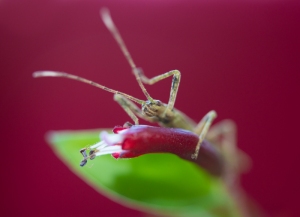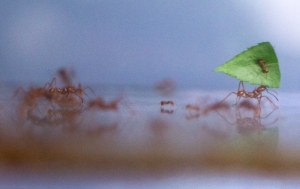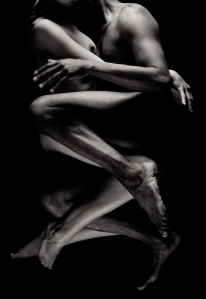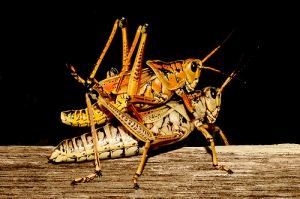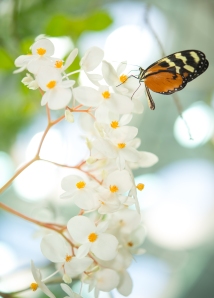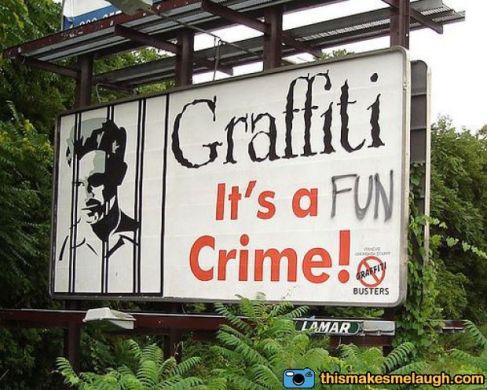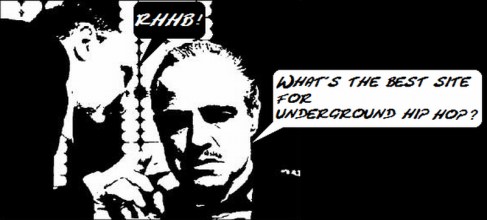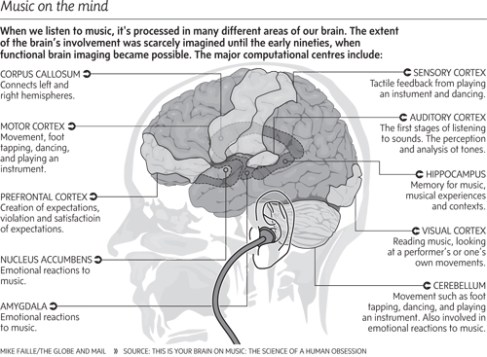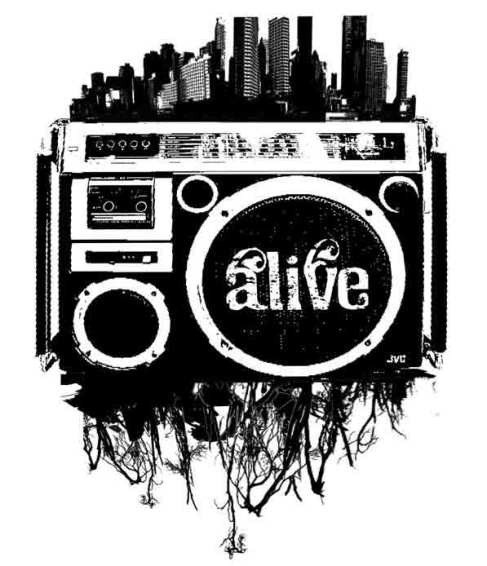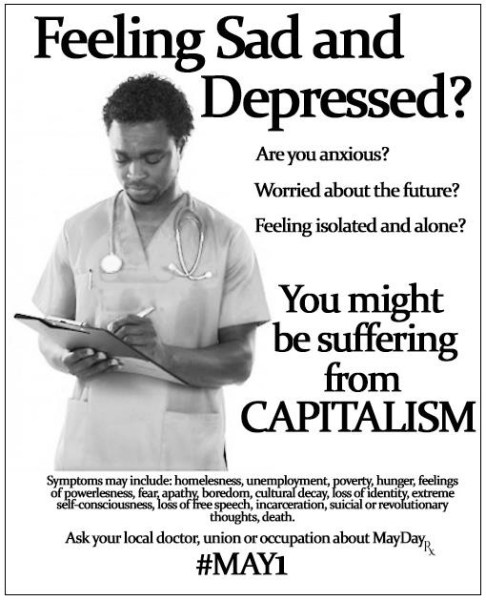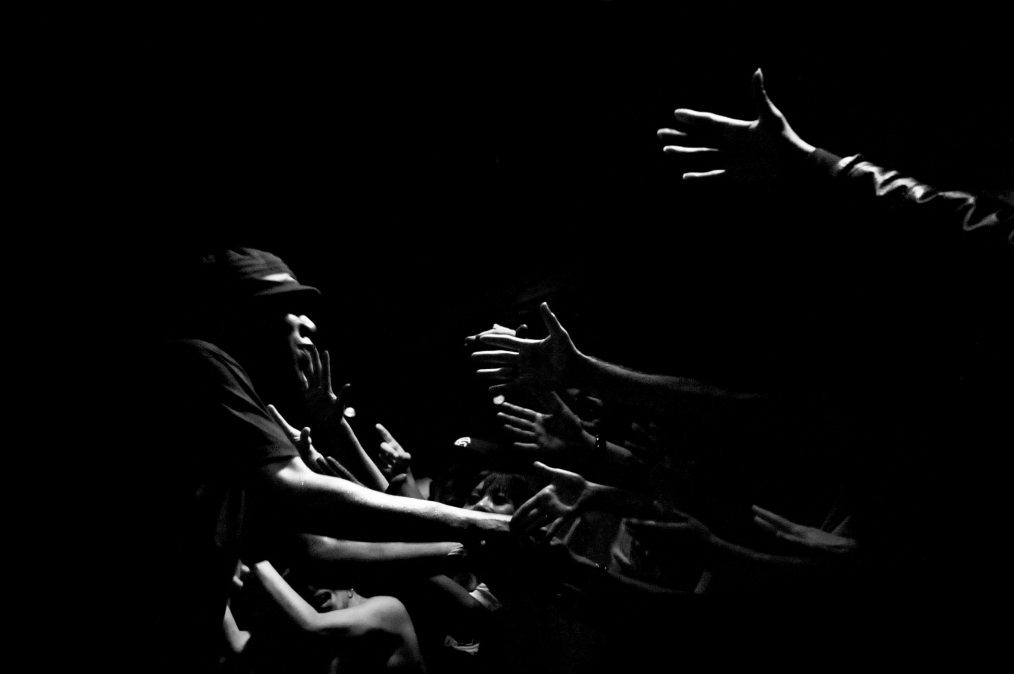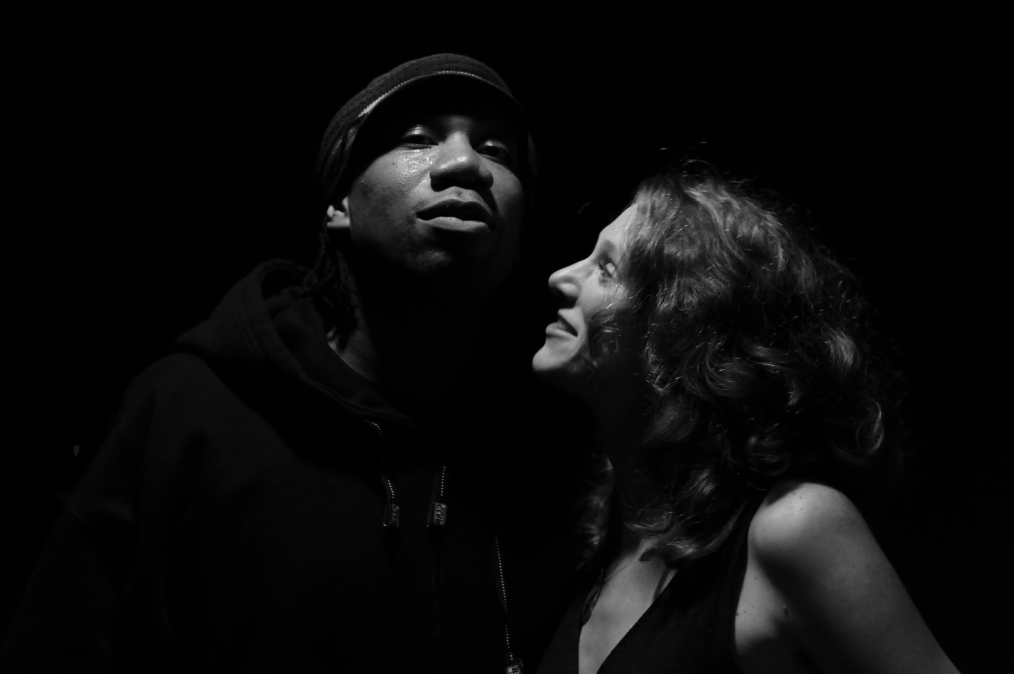Archive
A Pointed note on Martin Luther King, Jr Day
Three years ago I was out for a walk in Haiti when I met this boy who asked me to photograph him pointing to God. Aggrieved by the president’s recent disrespectful comments about Haiti, I am posting this as a reminder of what even the youngest of Haitian children know: There is a power higher than that of any president.
Occupy Wonder!
Now that summer is here, it’s time to unschool ourselves.
At the beginning of every school year, I ask my students to consider the question, “What is the purpose of education?” Most students understand from experience that schooling is at least in part an exercise in obedience to authority, in conformity to expectations, in bureaucracy, in knowing your place in the social and academic hierarchy. As one astute 14-year-old put it bluntly, “We’re here to be ranked and sorted.”
I shudder at the thought that my role as a teacher is to sort the winners from the losers. Like most educators, I’m aiming for a loftier mission: to unleash the curiosity and capacity for wonder that are inborn in each of us. Ironically, that mission might be best accomplished in the summer time, in the context of leisure, when the mind is at rest and at play, free from the strictures and dictates of institutional schooling.
At the end of every school year, I ask my students, “What will you think about when you are not being told what to think about? Are you prepared to trade the comforts of intellectual obedience for the risks of intellectual independence? How will you pursue your curiosities? What sets you on fire intellectually, and how will you fan those flames? What will you write feverishly in your Book of Questions?” These are the same questions we must ask ourselves as educators, as people modeling intellectual engagement, as propagandists for the Life of the Mind.
What ignites my curiosity, reliably, is insects. I just got my hands on a compound stereoscope and some live stick insects and I have the whole summer ahead of me.
What ignites your curiosity?
A girl considers insects under a microscope at the new Gallery of Natural Sciences at the Oakland Museum of California. Photo by Becky Jaffe
“The cure for boredom is curiosity. There is no cure for curiosity.” – Dorothy Parker
Is That a Math Poem in Your Pocket?
This is a guest post by Becky Jaffe.
Today is National Poem in your Pocket Day, a good day to wear extra pockets.
April also just so happens to be National Poetry Month and Mathematics Awareness Month. Good gods, such abundance! In celebration of the marriage of the left and right hemispheres of the brain, I bring you a selection of poems dedicated to the fine art of mathematics – everything from the mystical to the sassy. Enjoy!
——
from Treatise on Infinite Series by Jacob Bernoulli
Even as the finite encloses an infinite series
And in the unlimited limits appear,
So the soul of immensity dwells in minutia
And in narrowest limits no limits inhere.
What joy to discern the minute in infinity!
The vast to perceive in the small, what divinity!
——
Biblical PI
A Biblical version of pi
Is recorded by some unknown guy
In “Kings,” * where he mentions
A basin’s dimensions —
Not exact, but a pretty good try.
* I Kings 7:23
——
Sir Isaac Newton by Paul Ritger
While studying pressures and suctions,
Sir Isaac performed some deductions,
“Fill a mug to the brim, it
Will then reach a limit,
So easily determined by fluxions.”
——
A New Solution to an Old Problem by Eleanor Ninestein
The Topologist’s child was quite hyper
‘Til she wore a Moebius diaper.
The mess on the inside
Was thus on the outside
And it was easy for someone to wipe her.
——
Threes by John Atherton
I think that I shall never c
A # lovelier than 3;
For 3 < 6 or 4,
And than 1 it’s slightly more.
All things in nature come in 3s,
Like … , trio’s, Q.E.D.s;
While $s gain more dignity
if augmented 3 x 3 —
A 3 whose slender curves are pressed
By banks, for compound interest;
Oh, would that, paying loans or rent,
My rates were only 3%!
3² expands with rapture free,
And reaches toward infinity;
3 complements each x and y,
And intimately lives with pi.
A circle’s # of °
Are best ÷ up by 3s,
But wrapped in dim obscurity
Is the square root of 3.
Atoms are split by men like me,
But only God is 1 in 3.
——
Valentine
You disintegrate my differential,
You dislocate my focus.
My pulse goes up like an exponential
whenever you cross my locus.
Without you, sets are null and void —
so won’t you be my cardioid?
——
An Integral Limerick by Betsy Devine and Joel E. Cohen
Here’s a limerick —
Which, of course, translates to:
Integral z-squared dz
from 1 to the cube root of 3
times the cosine
of three pi over 9
equals log of the cube root of ‘e’.
——
PROF OF PROFS By Geoffrey Brock
I was a math major—fond of all things rational.
It was the first day of my first poetry class.
The prof, with the air of a priest at Latin mass,
told us that we could “make great poetry personal,”
could own it, since poetry we memorize sings
inside us always. By way of illustration
he began reciting Shelley with real passion,
but stopped at “Ozymandias, King of Kings;
Look on my Works, ye Mighty, and despair!”—
because, with that last plosive, his top denture
popped from his mouth and bounced off an empty chair.
He blinked, then offered, as postscript to his lecture,
a promise so splendid it made me give up math:
“More thingth like that will happen in thith clath.”
——
The last poem in today’s guest post is by a mathematician who proved the Kissing Circles Theorem, which states that if four circles are all tangent to each other, then they must intersect at six distinct points. Frederick Soddy wrote up his proof in the form of a poem, published in 1936 in Nature magazine.
The Kiss Precise By Frederick Soddy
For pairs of lips to kiss maybe
Involves no trigonometry.
This not so when four circles kiss
Each one the other three.
To bring this off the four must be
As three in one or one in three.
If one in three, beyond a doubt
Each gets three kisses from without.
If three in one, then is that one
Thrice kissed internally.
Four circles to the kissing come.
The smaller are the benter.
The bend is just the inverse of
The distance form the center.
Though their intrigue left Euclid dumb
There’s now no need for rule of thumb.
Since zero bend’s a dead straight line
And concave bends have minus sign,
The sum of the squares of all four bends
Is half the square of their sum.
To spy out spherical affairs
An oscular surveyor
Might find the task laborious,
The sphere is much the gayer,
And now besides the pair of pairs
A fifth sphere in the kissing shares.
Yet, signs and zero as before,
For each to kiss the other four
The square of the sum of all five bends
Is thrice the sum of their squares.
in Nature, June 20, 1936
——
The publication of this proof was followed six months later with an additional verse by Thorold Gosset, who generalized the case.
The Kiss Precise (generalized) by Thorold Gosset
And let us not confine our cares
To simple circles, planes and spheres,
But rise to hyper flats and bends
Where kissing multiple appears,
In n-ic space the kissing pairs
Are hyperspheres, and Truth declares,
As n + 2 such osculate
Each with an n + 1 fold mate
The square of the sum of all the bends
Is n times the sum of their squares.
in Nature, January 9, 1937.
——
This was further amended by Fred Lunnon, who added a final verse:
The Kiss Precise (Further Generalized) by Fred Lunnon
How frightfully pedestrian
My predecessors were
To pose in space Euclidean
Each fraternising sphere!
Let Gauss’ k squared be positive
When space becomes elliptic,
And conversely turn negative
For spaces hyperbolic:
Squared sum of bends is sum times n
Of twice k squared plus squares of bends.
——
These three raised the bar for presentation of mathematical proof and dialogue, throwing down the gauntlet to modern mathematicians to versify their findings. Who, dear readers, is up for the challenge?
Happy Poem in Your Pocket Day!
Nerd Nite: A Drunken Venue for Ideas
MathBabe recently wrote an article critical of the elitist nature of Ted Talks, which you can read here. Fortunately for her, and for the hoi polloi everywhere clamoring for populist science edutainment, there is an alternative: Nerd Nite. Once a month, in cities all over the globe, nerds herd into a local bar and turn it into a low-brow forum for innovative science ideas. Think Ted Talks on tequila.
Each month, three speakers present talks for 20-30 minutes, followed by questions and answers from the invariably sold-out audience. The monthly forum gives professional and amateur scientists an opportunity to explain their fairly abstruse specialties accessibly to a lay audience – a valuable skill. Since the emphasis is on science entertainment, it also gives the speakers a chance to present their ideas in a more engaging way: in iambic pentameter, in drag with a tuba, in three-part harmony, or via interpretive dance – an invaluable skill. The resulting atmosphere is informal, delightfully debauched, and refreshingly pro-science.
Slaking our thirst for both science education and mojitos, Nerd Nite started small but quickly went viral. Nerd Nites are now being held in 50 cities, from San Francisco to Kansas City and Auckland to Liberia. You can find the full listing of cities here; if you don’t see one near you, start one!
Last Wednesday night I was twitterpated to be one of three guest nerds sharing the stage at San Francisco’s Nerd Nite. I put the chic back into geek with a biology talk entitled “Genital Plugs, Projectile Penises, and Gay Butterflies: A Naturalist Explains the Birds and the Bees.”
A video recording of the presentation will be available online soon, but in the meantime, here’s a tantalizing clip from the talk, in which Isabella Rossellini explains the mating habits of the bee. Warning: this is scientifically sexy.
I shared the stage with Chris Anderson, who gave a fascinating talk on how the DIY community is building drones out of legos and open-source software. These DIY drones fly below government regulation and can be used for non-military applications, something we hear far too little of in the daily war digest that passes for news. The other speaker was Mark Rosin of the UK-based Guerrilla Science project. This clever organization reaches out to audiences at non-science venues, such as music concerts, and conducts entertaining presentations that teach core science ideas. As part of his presentation Mark used 250 inflated balloons and a bass amp to demonstrate the physics concept of resonance.
If your curiosity has been piqued and you’d like to check out an upcoming Nerd Nite, consider attending the upcoming Nerdtacular, the first Nerd Nite Global Festival, to be held this August 16-18th in Brooklyn, New York.
The global Nerdtacular: Now that’s an idea worth spreading.
Aunt Orthoptera: Advice from an Arthropod
Greetings from Aunt Orthoptera!
(Photo by Becky Jaffe)
This week I am guest blogging for Aunt Pythia, answering all of your queries from the perspective of a variety of insect species, naturally.
——
Dear Aunt Orthoptera,
My friend just started an advice column. She says she only wants “real” questions. But the membrane between truth and falsity is, as we all know, much more porous and permeable than this reductive boolean schema. What should I do?
Sincerely,
Mergatroid
P.S. I have a friend who always shows up to dinner parties empty-handed. What should I do?
Dear Mergatroid,
As I grant your point entirely, I will address only your postscript. What should you do with a friend who shows up to dinner parties empty-handed? Fill her hands with food. As an ant, I have two stomachs: a “social stomach,” and a private stomach. When I pass one of my sisters on our path, we touch each other’s antennae and communicate our needs via pheromones. If she is hungry, we kiss, a process unimaginatively called “trophallaxis” by your scientists. I feed her from my social stomach, and I trust she will do the same for me later – or if not her, exactly, another sister in whom the twin hungers for self-interest and interdependence coexist.
Anatomy as metaphor,
Aunt Orthoptera aka Ms. Myrmecology
(Photo by Becky Jaffe)
——
Dear Aunt Orthoptera,
I am struggling with emotional loneliness. Do you think it is possible to be happy – or even just productive – in life without a stable romantic relationship? If so, how? I have a couple close friends I can talk with, but they are in their own relationships and they are often too busy to have time to talk. I am in my early thirties and never had a girlfriend despite trying for nearly a decade. I have tried speed-dating, been on eharmony, match, ok cupid, asked friends to set me up, asked out a classmate in grad school, joined meetup groups. I am a nice guy but I have my flaws (nothing horrible) – I am kind of introverted, somewhat boring, and am consumed with my career (I’m untenured). It is so hard to meet people that I am compatible with – especially since I am a shy guy (perhaps it’s not surprising I am a math professor – I LOVE my job, by the way). I found ok cupid to be useful for identifying possibly compatible women but most women don’t respond to my messages. I was lucky to manage to get to go on first (and last) dates with two women I messaged on ok cupid last year, and was interested in going on more dates with both, but both of them declined, even though they both told me I seemed like a good person – “you seem like one of the nicest guys I met” is a direct quote, but that they didn’t feel there was any “chemistry”. This month I have been heartbroken over one of them. All this has been affecting my productivity.
Sincerely,
Singleton
Dear Singleton,
In my anthropological studies of humans, I have observed that you are yearning creatures. Your inexorable primateness destines you to a life of longing for social contact. As a solitary insect, I both pity and admire this craving for connection with your kind. My advice to you is to have compassion for your fundamental humanness. Your yearning for pair bonding is normal; it’s in your nature to want to entangle yourself with another. As creatures born of DNA, pair bonding operates at both the molecular level (e.g. Cytosine pair-bonds with Guanine) and the organismal level (woman to man, man to man, woman to woman).
(Photo: Double Helix by Becky Jaffe)
I suspect there’s another lonely strand of DNA out there for you, worth waiting for.
(Photo by Becky Jaffe)
I hope you find your mate!
Flirting with Sociobiology,
Aunt Orthoptera
——
Dear Aunt Orthoptera,
Do you have any self-soothing advice for when self-doubt, lack of confidence, and depression begin to take over?
Sincerely,
Feeling Very Small
Dear FVS,
As a tiny butterfly, I can assure you that it is ok to feel small. Here is my advice to you when you feel this way: Don’t just stop and smell the flowers, nuzzle in them.
(Photo by Becky Jaffe)
Let your worries float away for a little while and drift toward the sweetest thing you can find. When viewed through a compound lens, the whole world can look like nectar.
Spring springs eternal,
Aunt Orthoptera aka Lady Lepidoptera
——
Dear Aunt Orthoptera,
How will you enquire into that which you do not know?
Meno
Excellent question, Musing Meno.
The answer is: with great patience, dear Grasshopper.
(Photo by Becky Jaffe)
Next week, the inimitable Aunt Pythia will return with human advice for you. You can use the form below to submit questions.
Wishing you harmony in your hive and honey to thrive,
Aunt Orthoptera
Hip Hop’s Cambrian Explosion: Part 3
My last post left off on the topic of rap battles, element #16 in the Elements of Hip Hop. As one astute reader points out, Hip Hop is a culture as much as it is a musical genre. And as in any culture, the values are contested in public fora. The rap battle is only one arena in which the values of Hip Hop are contested and negotiated. Hip Hop also finds expression in dance and the visual arts.
Breakdancing was an early choreographic innovation that contributed to Hip Hop’s meteoric rise in popularity.
It later speciated into two new dance styles, popping and krumping. The documentary Rize showcases the talented pioneers of krumping, an athletic dance/fight form that calls to mind the Brazilian martial art of capoeira. The film situates krumping in its historical and social context, chronicling how it emerged in improverished neighborhoods in South Central LA as a community-building alternative to gangs and an outlet for artistic expression. Its founders, who see it as a faith-based practice, cite krumping’s capacity to “release anger, aggression, and frustration positively, in a non-violent way.”
The film is a testament to the power of art to heal and transform suffering, but it’s also just good eye candy. It’s the best of Cirque de Soleil – the reticulated musculature, the contortionism, the elastic gesture, the disdain for gravity – but without the fancy sets and high ticket prices, performed on a street corner for free and for freedom.
Another forum for Hip Hop’s artistic expression is the graffiti battle. Or “aerosol art.” The annual Estria Invitational Graffiti Battle draws together artists from around the country to compete in a day-long public visual arts contest. This video of the 2011 Estria battle illustrates the form: artists are given five hours and the challenge of incorporating the same word into their public art piece. Last year’s word was “Heal.” As Nate One explains in the video, “Art is not a drug; it’s free, and when you do it, it makes you feel better. That’s magic!”
Sometimes art is the only way to transform a dire situation. Street artist Banksy, featured in the riveting and somewhat surreal documentary Exit Through the Gift Shop, turned the wall separating Israel from Palestine into a canvas of possibility.
So why is the Academy of Art University in San Francisco not only participating in anti-graffiti campaigns, but using their anti-graffiti efforts to recruit new students in their promotional advertisements? I would think they would be more interested in hiring Banksy as a professor than white-washing street art. But since tuition alone for an undergraduate degree at the Academy of Art costs approximately $80,000, my hunch is that it has something to do with classism. Fortunately, the top-notch Oakland Museum of California is more supportive of local artists, sponsoring the Living Concrete live graffiti mural painting festival.
Together, Hip Hop’s rap battles, dance battles, and graffiti battles are venues for positive artistic expression, bringing me to the next point in this protracted paean to Hip Hop.
7. Hip Hop is positive. Hip Hop receives a lot of negative attention in the media for its materialism, its machismo, and its militance. Those are accurate descriptors of mainstream rap, perhaps, but Hip Hop is a large umbrella that shelters many subcultures. It’s such a large category, in fact, that describing it is like trying to describe Christianity, which encompasses myriad splinter groups with ideologies as distinct from each other as Lutheranism is from Mormonism. As distinct as gangsta rap is from underground Hip Hop.
Rapper Too Short, representative of the former subculture, was in the news this week for some ill-advised “advice” he gave to young boys in a youtube video. The organization We Are the 44% called him on the carpet for promoting sexual violence against young women. You can read about the town hall discussion that ensued here, on Davey D’s blog.
Given the range of subcultures within Hip Hop, with Too Short arguably on one end, it’s painting with perhaps too broad a stroke to describe all of Hip Hop as positive. The media, however, tend to focus on Hip Hop’s more negative aspects and overlook the positive ones, which abound. Consider Shad’s Keep Shining, which is a welcome antidote to Too Short’s views:
My mom taught me where to keep my heart,
My aunts taught me how to sing two parts,
My sis taught me how to parallel park,
Tried to teach me math but she’s way too smart.
My grandma in her 80′s is still sharp,
My girl cousin’s in activism and art.
They taught me there’s no curls too tight
No mind to bright,
No skin too dark to keep shining!
I got off the 2 train in Brooklyn on my way to a session
Said let me help this woman up the stairs before I get to steppin’
We got in a conversation, she said she was 107.
Just her presence was a blessing,
and her essence was a lesson.
She had her head wrapped
And long dreads that peeked out the back
Like antenna to help her get a sense of where she was at.
Imagine that:
Livin’ a century,
the strength of her memories.
Felt like an angel had been sent to me.
She lived from nigger to colored to negro to black
To afro then african-american and right back to nigger.
You figure she’d be bitter in the twilight,
But she alright, ’cause she done seen the circle of life.
Hers is a story of resilience, and what’s more positive than resilience?
As you may have inferred from the tracks I’ve referenced so far, I eschew the brand of rap that glorifies guns and denigrates women and listen to what’s referred to as “progressive,” “underground,” or “conscious” Hip Hop. In contrast to the more commercially successful rap, the underground stuff is so positive and upbeat that I’ve dubbed it “Self Help Hip Hop,” or when I’m feeling really cheesy, Hip Hope.
I’m referring to groups like Atlanta-based Collective Efforts with tracks like Doin’ Alright and Try Again. Here’s one blogger’s picks for the Top 10 Progressive Hip Hop Artists. Self Help Hip Hop is values-based music, and one of its core values is gratitude. One of my favorite songs is by Brother Ali, written to his young son, Faheem. Ours has been described as a fatherless generation, and in that context his words are refreshingly sentimental:
I fed you, changed you, read to you and bathed you.
I ain’t trying to hold that over your head; I’m saying ‘thank you.’
K’Naan’s 15 Minutes Away is an object lesson in the value of generosity. He opens the song recounting his pre-immigration experience of being “broke like an empty promise,” destitute to the point of hunger. I feel for him as he jokes about anxiously awaiting a Western Union money transfer. The song follows his arrival in Canada as a refugee and his subsequent rise in fame as a musician, and ultimately comes full circle as he describes rushing from the concert venue to the Western Union office to send money to his grandmother. “Generosity is the key!” he intones. And he repeats it twice, in case we weren’t paying attention: Generosity is the key.
While detailing explicitly the hardships of life, hip-hop music often concludes its narratives with the hopeful assertion that odds can be overcome – as evidenced, if nothing else, by the fact of the individual rapper’s rise to fame. And it’s not just the lyrics and the message that make Hip Hop positive. The music itself may be operating on a molecular level to lift your mood, according to Oliver Sack’s characteristically charming Musicophilia. Dr. Sacks provides insights into the neurology of listening to music, including how it raises serotonin levels and other biochemical agents of wellbeing.
I might be paraphrasing here, but I think what Dr. Sacks is saying is:
8. Hip Hop is funky. For all its incisive analysis, creative rhyme schemes, and positive poetry, I like Hip Hop mostly because it feels good. It gets me reaquainted with my soul via my hips. I challenge you to NOT do the Humpty Dance. I defy you to NOT get down at Collective Efforts’ I Get Down. Or Shad’s I Get Down.
Rapper Lyrics Born, with a voice like Paul Robeson, joins James Brown in my personal Hall of Funk Fame for his ode to the Bay Area, The Bay. Ozomatli’s Cut Chemist is a groovalicious blend of Chali 2Na’s deep bass vocals and a punctuated latin brass section reminiscent of the Buena Vista Social Club. In this video of Cut Chemist the funk is in effect.
As Chali 2Na, the Ghetto Diplomat, says: “I’m blessed with the gift of rap.”
I couldn’t agree more.
*****
So, Mathbabe, my answer to your question is that Hip Hop is very much
Addendum: My secret agenda in writing this blog was not only to celebrate Hip Hop, but to trawl for new music. If you have a favorite Hip Hop song to recommend, I want to hear it. Please post a link in the comments section below.
I’m particularly interested in what I haven’t heard so far, and what could be the next logical leap in its Cambrian explosion: Eco-rap. In fact, consider this a call for entries. I want to hear a rainforest redemption rap, one that samples an owl’s rhythmic hoot, remixes a cricket choir, and layers in a Wangari Matthai recording on reforestation. What would an Earth First! anthem by Busta Rhymes sound like? I want to hear Shakira and Nas team up to write a rap requiem on soil erosion. KRS One, if you’re reading this, there’s a lacuna in the curriculum.
Propaganda with a Caveat
Caveat: “Under Capitalism, man exploits man; under Communism, it’s the other way around.”
– John Kenneth Galbraith
Interlude: Egret Ardor
Snowy Egret
A late summer night and the snowy egret
has come again to the shallows in front of my house
as he has for forty years.
Don’t think he is a casual part of my life,
that white stroke in the dark.
– Mary Oliver
Hip Hop’s Cambrian Explosion: Part 2
Since Cee Lo got the last word on the previous post, the first word of today’s guest post goes to Senegalese rapper Sister Fa. The word is Sarabah, the inspiration for point 4 in this prolix paean to Hip Hop.
4. Hip Hop is international. Although it originated in the African American community as a critique of white supremacy and an expression of community pride, it has gained international popularity over the past three decades, going viral as a musical meme, and inspiring artists from across the globe to adapt it and hybridize it with local traditions. To make a biological analogy, Hip Hop has undergone a global adaptive radiation to rival that of the Cambrian explosion.
I highly recommend the documentary film The Furious Force of Rhymes, which includes interviews with rappers in Senegal, Israel/Palestine, the United States, and Germany, chronicling its global appeal and rapid evolution. The film is a tribute to young artists who are drawn to Hip Hop as a vehicle for exploring social and political inequalities. Artists like Sister Fa, who raps in Wolof, Manding, Jola, and French. Her song Life Am reads like a public service announcement about the importance of practicing safe sex to contain the AIDS epidemic, but it’s the catchiest PSA I’ve ever heard, which is why it’s so effective. I find myself singing along to the rhythmic “utiliser le preservatif” only to realize that’s about the least sexy thing it’s possible to say in French. Voici une video, Milyamba. Sister Fa is leveraging her fame as a rapper to campaign throughout West Africa against female genital mutilation. Subjected to the practice herself, she tells her story in the documentary film about her life and activism entitled Sarabah.
Sister Fa’s use of multiple languages in the course of one song is typical of the way in which international artists have embellished the form and upleveled the wordplay. I’m particularly fond of songs that blend English with other languages, like Ozomatli’s Nada’s Por Free, sung in Spanglish (“So me levanto off the suelo straight chillando with my pena.” Ha!). I’m kvelling over this video of Ozomatli performing in Spanglish at the Tu B’Shvat Nature Fest.
Code-switching and language-switching are natural stylistic choices for a medium concerned with raising questions about racial identity. It was not so long ago that Apartheid imposed arbitrary racial categories on South Africans and enforced them with singular cruelty. (Check out this excellent documentary on Apartheid featuring Archbishop Desmond Tutu.) In the context of a country attempting to decolonize its national psyche and forge more pluralistic and inclusive social structures, rapper Emile YX uses Xhosa, Zulu, English and Afrikaans to explore lingering questions of racial identity.
In Who Am I? Emile YX mixes it up like the chromosomes in his name:
I’m every brother and sister
Working in a factory
I’m Easter weekend
camping at Kommetjie
I’m Sunday braaivleis
Dik geeet en gaan slaap
I’m that stone thrower at Caspers
During Apartheid innie Kaap
I’m that dummies player, kennetjie en Akoos
I’m that ANC supporter saying the DA se ma se,
I’m that voes gamtaal talker, corner broker
Gooi neer jou tol want hier gaan jy stoke ja,
I’m that mass marcher and tyre burner,
Minimal wage sub-economic earner
I’m that doctor, lawyer and politician in the ghetto
Wait a minute … Most of them have moved out though.
So I’m that one who stays to be a good role-model,
My election promises are not just oral.
Even when I can’t understand all the content of a song, I enjoy listening for Hip Hop’s recognizable elements, as well as the unique aspects that mark its cultural adaptation.
Here are a few gems:
In Spanish: Humanidad by Ana Tijoux
In Tagalog: Bebot by the Black Eyed Peas
In Japanese: Togesashi by Inden
In Arabic: Al Kuffiyeh 3Arabeyyeh by Shadia Mansour
With Hip Hop’s increasingly international reach, it is ever more pluralistic in both form and content. What is it exactly that makes the genre so appealing to a diverse global audience?
5. Hip Hop is democratic. A key stylistic convention of the genre involves using multiple first-person narrators who rotate in order to collectively construct the story as a mosaic. In the Black Eyed Peas’ Beautiful People, each of three narrators takes turns recounting his experience of coming into his own, overcoming the obstacles presented by anti-semitism, poverty, and the INS. Pinoy poet apl.de.ap tells his story:
Back in the days when I was in Philippines,
I had a dream to be heard and to be seen.
Came overseas at the age of fourteen,
Stood behind the front, if you know what I mean.
The song explores questions of worth – self-worth, material worth, innate worth — themes which are woven into each person’s narrative so that the song tells a collective story while still allowing each individual to express his unique perspective. Macy Gray sings the melody, an adaptation of the chorus from the Beatles’ Baby You’re a Rich Man With her wonderfully scratchy voice (What I wouldn’t give to bring Janis Joplin back from the dead to hear her and Macy Gray growl a duet!) she asks, “How does it feel to be one of the Beautiful People?” Collectively, the Black Eyed Peas convey a fairly democratic sentiment: You refugee, you immigrant, you down-and-out listener (and yes you, reader): You are the beautiful people.
Another favorite example of a song that uses rotating narrators to tell a single story is the Fugee’s Rumble in the Jungle. Seven narrators take turns paying homage to the historic boxing match between Muhammad Ali and George Foreman that took place in Zaire in197. At the height of the Black Power movement, Muhammad Ali’s journey back to Africa took on a significance and symbolism that became a source of shared pride bolstered further by the fact that Ali was the World Heavyweight Champion and a radical to boot. Ali was an early Conscientious Objector to the Vietnam War, stating succinctly, “I ain’t got no quarrel with them Viet Cong; No Viet Cong ever called me ‘nigger.’” The song opens with a quote by Ali, so in a sense he becomes an eighth narrator:
“I’m gonna fight for prestige, not for me, but to uplift my little brothers who are sleeping on concrete floors today in America, black people who are living on welfare, black people who can’t eat, black people who don’t know no knowledge of themselves, black people who don’t have no future. I want to win my title and walk down the allies, set on the garbage can with the wineheads. I wanna walk down the street with the dope addicts, talk to the prostitutes. So, I can help a lot of people.”
I recommend the documentary When We Were Kings, a biopic about Ali, which situates Rumble in the Jungle in its historical context, including the glaring irony of the event: the fact that it was funded by dictator Mobutu Sese Seko, who had only recently assumed power via coup after the C.I.A. orchestrated the overthrow of the democratically-elected Patrice Lumumba. For more on the story of this egregious episode in American foreign policy, two good resources are the film Lumumba and the book The Poisonwood Bible by Barbara Kingsolver, a fictional account of the period surrounding Lumumba’s assassination. Interestingly, her novel also uses the device of rotating first-person narrators to structure the story. When telling a story about democracy – or the deliberate undermining thereof – the technique of weaving multiple narrators’s perspectives is apt in that it models pluralism.
Women’s voices are too often missing in Hip Hop, so I am particularly smitten with Cell Block Tango/He Had It Comin’ by Macy Gray, L’il Kim, and Queen Latifah. This song uses the multiple-narrator format to address a serious topic in a campy tone: domestic violence. The song’s over-the-top Broadway style (it was written for the musical Chicago) signals to the listener that we are in the realm of fantasy as each artist imagines violent revenge against her lover/abuser. Queen Latifah sings the first verse with characteristic sassitude:
I mean imagine, why was he hittin’ his woman?
Why was she takin’ that?
Now picture her fightin’ back, picture the ass kickin’
Think of his ass flippin’ down the stairs
And me at the top smilin’, he shoulda stopped wildin’.
Now could you picture me tryin’ to finish him off?
See why I pictured me on this side of the law?
High heels leave holes, you’d a thought I was gunnin’!
Now the cops comin’, I ain’t runnin’!
Hip Hop is very much a macho, male-dominant form, misogyny being its blind spot. So Queen Latifah’s is a minority voice. But that’s just it. Even if yours is a minority opinion, if you can voice it with enough panache, and what you’re saying smacks of truth, then you can have your day in court in Hip Hop. The democratic nature of the form has a lot to do with the method by which rappers rise in fame and credibility: the rap battle.
6. Hip Hop is competitive. Emerging rappers can be recognized in public because they carry a notebook in their pocket which they frequently take out to jot down rap lyrics and song hooks. They are avid consumers of rap music, noting other rapper’s cadences and rhyme schemes, and honing their skills in cyphers. A cypher is a group of rappers who get together and take turns improvising raps either acapella or over a beat. If you have ever seen this live, you know how impressive this ability to extemporize is. Here’s a home-made video of a stellar cypher I saw live as part of the annual Life is Living Festival. (Check out the 9-year-old who rocks the mic at 3:20 and 13:28!) Cyphers provide creative community and serve as training grounds for the high-stakes battles that put rappers to the test. Many of you are familiar with the battle scene in Eminem’s 8-Mile, a film that is notorious in my mind largely for its terribly unsexy sex scene. (And they didn’t even “user le preservatif!”) Here’s a link to the final battle scene in 8-Mile, in which Eminem wins by confessing his flaws to the crowd first, stealing his opponent’s best ammunition.
In a rap battle, two artists at a time compete. They are each given a time limit, taking turns addressing each other back and forth, all the while wooing the crowd with their artistry and skills. When the beat drops – one they have not heard in advance – they have to deliver a performance that: a) belittles the competitor; b) self-aggrandizes; c) references a comment or event that just occurred, demonstrating that the lyrics are improvised in the moment; and d) impresses the crowd. This last one is critical, as it is the audience who decides who the winner is in an instant and rambunctious plebiscite. Picture an Occupy General Assembly, but with different hand gestures. Hip Hop’s virtuosos are vetted in the democratic forum of the rap battle.
Apropos of democracy and internationalism, I’ll give the last word of today’s post, part 2 of 3, to the Occupy Wall Street movement. Enjoy this funky rallying cry from Occupy London.
Cheers!
Interlude: Newt Haiku
Photo: The newt on the left hovers above an egg sac moments before approaching the beast with two tails on the right.
On one of the first unmistakable days of Spring, I led a group of five six-year-olds on a walk through the UC Botanical Garden, where I am a docent. I say “walk,” but children at that age do anything but: they skip, bound, trip, jostle, spin,and vibrate in a sort of Brownian motion, but rarely walk. On this first morning of emboldening sunlight and tentative short sleeves, my group was particularly kinetic, their effervescence reaching a feverish pitch when we arrived at the Japanese pool and found the newts in a similar frenzy. Pairs of newts gripped each other in slippery contortions, splashy displays that incited the childrens’ curiosity. Lone newts trailed after mating pairs, latching on to a tail and rolling into a tan-and-yellow tangle of three- four- and five-newt bundles. One of the children asked, “What is that brown knot?” The adult chaperones tittered. Since Spring has inspired haiku for centuries, I offer this reply, in haiku form.
What is that brown knot?
The newts are dancing, children,
celebrating Spring.
What is that brown knot?
The newts are wrestling, children,
That’s how life begins.
What is that brown knot?
A miracle of nature,
one more mystery.
What is that brown knot?
The newts are in love, children,
euphemistically.
What is that brown knot?
A good old-fashioned tussle,
a frenzy, a fray.
What is that brown knot?
Survival of the fittest,
Shuffling DNA.
What is that brown knot?
An amphibian orgy,
It’s rude, kids, to stare.
What is that brown knot?
Sexual reproduction.
Ask that docent there.
Hip Hop’s Cambrian Explosion: Part 1
On her January 28th post entitled Does Hip Hop Still Exist? Mathbabe wrote:
“My oldest friend sent me some mixed CDs for Christmas. I listened to them at work one recent morning, and although I like a few songs, many of them were downright jarring. I mean, so syncopated! So raw and violent! What the hell is this?! It was hip-hop, I think, although that was a word from some far-away time and place. Does hip-hop still exist?”
Fortunately for me, I am that oldest friend, mixer of said CD, and guest blogger this week, here to answer Mathbabe’s question with the first of a three-part post entitled Hip Hop’s Cambrian Explosion.
______________
I discovered Hip Hop around the same time I discovered Mathbabe. In 1987, Hip Hop was a toddler living in Brooklyn while Cathy and I were teenagers living in suburban Massachusetts. As I walked home from school one afternoon, I popped Boogie Down Production’s debut cassette into my walkman and snapped to attention as KRS One delivered a high-energy critique of public schooling’s systematic omission of Black history from the curriculum. As I listened I found myself considering for the first time the ways in which I had been raised on a steady academic diet of European and American histories and literatures, with no mention of those of Africa, Latin America, or Asia. These were entire continents and peoples whose histories were tacitly deemed peripheral to the central drama of whiteness. I listened closely as KRS One, aptly known as “The Teacher,” educated me about the people studiously ignored in my history textbooks. Here is a delightfully dated video of that first song, You Must Learn: http://www.youtube.com/watch?v=RDd7UbJmdmw.
I am now nearly 40 and recently had the opportunity to meet KRS One at a concert in Berkeley, where I was able to thank him in person for supplementing my education. He is as dynamic as I remember, still using the mic as a vehicle to teach critical thinking, still building community by inviting up-and-coming rappers onto the stage to improvise with him, still innovating by rapping over electric violins spilling amplified Mozart over the surging audience. In this photo I took from stageside he reaches out to connect with the crowd:
And here I am, looking up at him.
Photo by Hugo Garcia, aka Steelo
As you can see in the photo, I plainly admire him, as I do any iconoclast who has the audacity and clarity to say so when the Emperor has no clothes. So as an avid fan of Hip Hop, I’d like to appeal its case for those of you who are new to the genre or are considering giving it a second listen. Why should you bother listening to Hip Hop? And what exactly is Hip Hop anyway? I offer this primer as a paean.
1. Hip Hop is political. Hip Hop gained national attention in 1989 when Public Enemy’s Fight the Power piqued the paranoia of white America. The now-classic ghetto anthem opens with Martin Luther King’s lilting oratory, not the more tepid, politically-milktoast MLK Jr. of the official public holiday, but the radical MLK Jr, who exhorts Americans not only to refuse to serve in the U.S. Army, but to switch allegiance to fight alongside the Viet Cong.
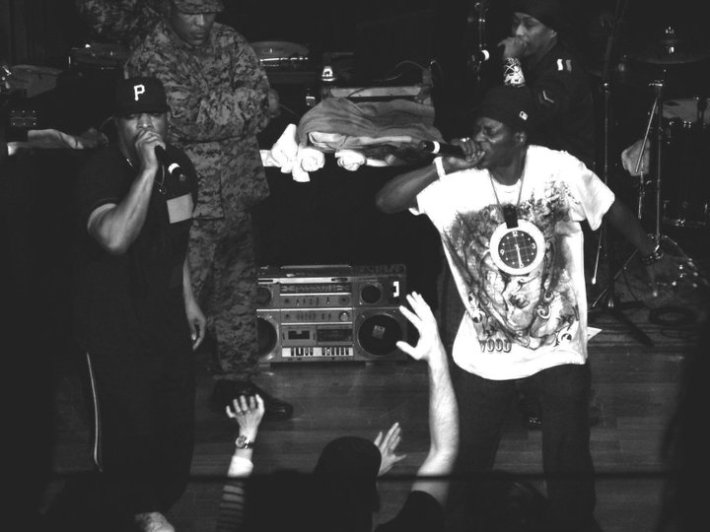 Chuck D and Flavor Flav at Yoshi’s in San Francisco. “Most of my heroes don’t appear on no stamps.” – Chuck D. Photo by Cherie Chavez
Chuck D and Flavor Flav at Yoshi’s in San Francisco. “Most of my heroes don’t appear on no stamps.” – Chuck D. Photo by Cherie Chavez
True to its origins, Hip Hop remains today the artistic genre of choice and the voicebox for people pushed to the margins of power by historical and social forces. And it’s not afraid to name those forces. Paramount among the themes tackled in Hip Hop is that of white supremacy, a topic — a phrase even — that tends to make white people uncomfortable. When rapper Brother Ali released Uncle Sam Goddamn, an overview of American racism — past and present — cell phone company Verizon responded by revoking its sponsorship of his tour. Corporations typically don’t profit by talking about racism, unless it’s in that “Rainbow Nation” manner of Benetton, which carefully eschews analysis of power relations. The video for Uncle Sam Goddamn includes some powerful historical footage.
Another of Hip Hop’s recurring themes is poverty. As Somalian-born rapper (and personal favorite) K’Naan explains:
…I remember when I was 7
When rap came mysteriously and made me feel 11
It understood me, and made my ghetto heaven
I understood it as the new poor people’s weapon.
Smart 7-year-old. The excerpt is from The African Way, a funky fusion of American-style rap vocals and East African drum rhythms. As K’Naan recounts in several of his autobiographical songs, he learned English by listening to rap music (it’s no coincidence he sounds so much like Eminem) in order to have a forum for speaking about the violence he experienced as a child growing up in his native Mogadishu. His beautiful Blues for the Horn is both lament and homage to the Horn of Africa. He narrates the story of Somalia himself so that no one can “make a mockery of our struggle like Hollywood plans to.” And despite the seriousness of his purpose, he carries on another of Hip Hop’s traditions: its sense of humor. Describing Mogadishu, he quips:
If you bring the world hoods to a seminar
We’re from the only place worse than Kandahar —
And that’s kinda hard!
In the song Somalia, he reminisces about his childhood:
We used to take barbed wire
Mold it around discarded bike tires,
Roll em down the hill in foot blazin’ —
Now that was our version of mountain bike racing!
Daaaaaammn!
Do you see why it’s amazing
When someone comes out of such a dire situation
And learns the English language,
Just to share his observations?
Probably get a Grammy without a grammar education.
Hip Hop has an unapologetic working class hero sensibility, like John Lennon’s Working Class Hero, but edgier. How’s this for edgier? 5 Million Ways to Kill a C.E.O.
The racism and classism that inhere in our justice system are the targets of Lauryn Hill’s epic rant in The Mystery of Iniquity. She seems to enter a poetic trance as she excoriates the American judicial system in a style that calls to mind the dogged dirge of Allen Ginsberg’s Howl. This is but a tiny excerpt of Hill’s stream-of-consciousness dressing down:
Do we expect the system made for the elect
To possibly judge correct?
Properly serve and protect?
Materially corrupt
Spiritually amuck…
Mafia with diplomas keeping us in a coma trying to own a piece
of the American Corona.
The revolving door:
Insanity every floor
Skyscraping, paper chasing,
What are we working for?
Empty traditions
Reaching social positions
Teaching ambition to support the family superstition?
With a bass voice like Barry White, rapper Lyrics Born questions our funding priorities in Stop Complaining:
I pay my taxes when I’m asked to.
I’m not enthusiastic about it, but shit, I make it happen.
Yeah, it’s last minute, but goddammit they cash it.
(“This is fiscal harassment, they keep touchin my assets!”)
Now I imagine I might be feeling different about it
If it was given outright, witness it helping somebody
But it just so happens in life, the school district’s too crowded
It ain’t no teachers in sight, that’s why the kids are so rowdy.
I just imagine some asshole with glasses on up at the Capitol
One of a thousand pawns packed in an office cramped up like animals,
Pictures of his sister, his mixture Lapso Apso-poodle
His 2.6 kids, and the missus thumbtacked to his cubicle
So damn detached from the average man’s planet, he cain’t fathom
That we could ever be anything other than stats, fat and taxable
He’s gettin his usual ritual 2 o’clock Cup of Noodles on
While he’s fuckin you on your W2, his John Denver music on.
The ongoing disparities in K-12 schooling and access to higher education are a common theme in Hip Hop. Shad K, who pursued his career in Hip Hop while simultaneously earning a Masters degree in Business, writes in Exile:
We’re taught not to question the status quo cuz the masses never get heard
unless you’re established
with expert professors in dress-shirts
and glasses that lecture to classes
from lecterns
where next term the best third will pass and
earn cash working as
desk clerks for the best firms in Manhattan.
Shad was born in Kenya, the son of Rwandan refugee Bernadette Kabango, whose autobiographical poetry he incorporates in the chilling song I’ll Never Understand. Shad’s mother reads in her own voice, telling the story of her family’s murder in the 1994 genocide, addressing those who committed violence against her, and raising questions about the possibility of forgiveness. Shad’s rap vocals interlace with his mother’s voice, interjecting questions about whose genocides matter and whose don’t. The video of I’ll Never Understand includes footage that defies commentary from the Rwandan massacres. How could one begin to talk about such atrocities but through art? As writer Victor Hugo observed, “Music expresses that which cannot be said and on which it is impossible to be silent.”
The musical conversation between mother and son brings me to Hip Hop’s next defining characteristic.
2. Hip Hop is intergenerational. One of the stylistic and structural conventions of the genre is sampling. The contemporary artist layers his/her vocal track over a repeated excerpt of a melodic track — the sample — by an older artist, alive or dead. The tradition of sampling older artists from a generation prior (e.g., Nina Simone, Ray Charles, etc.) began perhaps for practical reasons, as access to older songs was not limited by royalties and copyright. Regardless of the motivation, sampling has the effect of creating intergenerational dialogue, a musical conversation across time.
Hip Hop has its roots in the oral traditions of West Africa, where people still live in active relationship with their ancestors and respect for elders is a core cultural value. Hip Hop carries on this tradition of talking with the dead and honoring those who have paved the way. Erick Sermon’s Just Like Music is an ode to music’s healing power (“I wish music could adopt me!”), sampling musical legend Marvin Gaye. Sermon cleverly interweaves his contemporary vocals over Marvin Gaye’s melodies so that at one point they appear to be in direct conversation:
Sermon: Is that true, Marvin?
Gaye: Yeeeeeeaaah!
It’s no surprise that songs from the Civil Rights movement provide a rich pool of sampling material. Movin’ Forward by Collective Efforts samples Civil Rights song Ain’t Gonna Let Nobody Turn Me Around, and references Eyes on the Prize, the comprehensive and inspiring documentary on the history of the Civil Rights movement.
Fort Minor’s Kenji tells the story of the United States internment of Japanese Americans during World War II and honors elder survivors by incorporating original audio interviews of former internees.
I’ve talked a lot about politics here, but if Hip Hop were all politics, it would be two-dimensional, flat like a Soviet-era agitprop poster (you know the ones of the workers with the disproportionately huge fists). It is the next characteristic which gives Hip Hop its complexity, dynamism, and multi-dimensionality.
3. Hip Hop is poetry. On steroids. A bit like aural caffeine. While I first got hooked on rap for its incisive outsider critiques, I equally enjoy the verbal acrobatics and linguistic playfulness of the form. I’m a word nerd, a sesquipedalian, easily wooed by an orator who can wield an adjective, so the highly verbal genre holds a natural appeal for me.
Others have told me that they find the language of Hip Hop itself a barrier to listening, the lyrics so rapid-fire and abstruse as to be unintelligible to the uninitiated. Perhaps so, but many of us found Shakespeare difficult to parse at the beginning but ultimately worth the effort. As in any specialized field, rap has created a unique language, its own grid of intelligibility, with webs of cross-references and insider lingo that can be opaque to newcomers to the genre. Just as you would read Shakespeare with a dictionary at your side as a reference to make meaning of the text, rap music lyrics must be studied with the right reference materials at hand. The rate of word evolution in rap music is rapid, which can make it difficult to keep up with the neologisms. Fortunately, there’s Urban Dictionary, with user-entered definitions being added continuously.
Approaching Hip Hop with the same spirit of literary criticism used to analyze Shakespeare or T.S. Eliot reveals that its poets employ all of the literary devices standard in the craft: alliteration, assonance, consonance, onomatopoeia, irony, and variation. They amplify the metrical effects of diction and syntax with the percussion and syncopation provided by the music itself. It is the interplay of the two (or more often, multiple) meters – the rhythm inherent in language, and the nonvocal rhythms of layered drums, piano, trumpet, or kora – that so stimulates the linguistically-inclined mind.
What rap adds to the traditional toolbox available to written poetry is a tool only available to the spoken word artist: something called flow. Flow is a bit difficult to describe, but you know it when you hear it. Flow is that state a rapper gets into when the syllables are tumbling off the tongue in a waterfall of words, the cadences rising and falling, surprising and mesmerizing. Flow is that trance artists crave, that moment when the rational mind steps aside, time telescopes, and the artist becomes hypnotized by the presence of the muse. Flow is when the music comes through the musician rather than from the musician. Cee-Lo has it. I couldn’t agree more with his self-review in One for the Road: “Oh, his way with words! I want seconds and thirds!”
I’ll let Cee Lo have the last word for now, and will continue tomorrow with Part 2 of Hip Hop’s Cambrian Explosion.





